
08 Mar A Local’s Guide to Budapest’s Thermal Baths
Budapest is known throughout the world as the city of spas. In fact, the entire country of Hungary rests upon an absolute bounty of geothermal, medicinal wonder. There are plenty of amazing opportunities in the countryside, ranging from the famous medicinal pond of Héviz to the stinky, sulfuric, iodine-infused splendor of the eastern provinces.
Now as for the history of the baths in Budapest. We can summarize in saying that every single culture that has ever laid down roots in Budapest, from the ancient Celtic Eraviscii who called this plae Ak-Ink (‘of the water’), to the Romans, those great, swaggering bath lovers who took that name and transformed it to “Aquincum” (the ruins of which can still be visited at the Aquincum Museum in District III), to the Huns and the Avars and Magyars and beyond. And of course, the empires who have held sway in Budapest were sure to leave their mark as well.
Most specifically we refer here to the Ottomans and the Habsburgs and even the Soviets.
And whatever you feel about the historical oppression unleashed by these various imperial systems, it is undeniable that they left behind some outstanding and architecturally stunning bathhouses. And that’s why Budapest is the best spa city in the world. Because you can spend an entire week here soaking in the ancient past.
There are many different options for visitors to Budapest who are interested in sampling the thermal waters. To make things easier to follow we’ve separated them into a few different categories.
The first category we will call the classic tourist spots. These are the heavy-hitting, Instagram-friendly, expensive (but still relatively cheap compared to equivalent top-end spas in Europe). Listen, these places are fantastic. True shrines to bathing.
However, you are going to have to deal with a lot of potentially annoying elements (depending on your personal level of irritability). By this, we mean crowded pools, lots of other tourists, high prices and sometimes a less than hygienic experience. WITH ALL OF THAT BEING SAID, these are amazing spots and some would even argue must-see.
In the following category, we will go over some more authentic, cheaper options. To be honest, if you are here as a tourist, it would be fairly criminal not to visit at least one of these three.
Most Popular Thermal Baths in Budapest
Széchenyi Thermal Bath
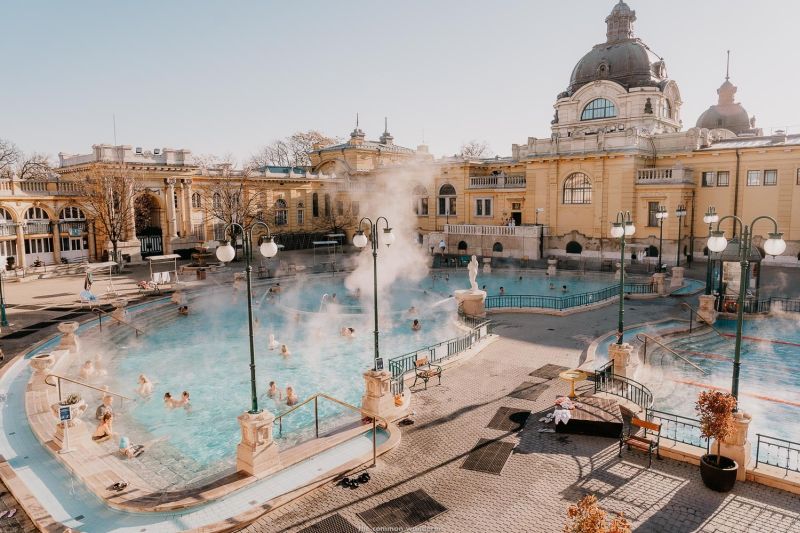
Photo: unsplash.com
Széchenyi Bath is the biggest and most illustrious of the lot. Architecturally it lives in the right before World War I, an embarrassment of decadence that the Habsburg Empire became. But as with all turn-of-the-century architecture in Budapest, this building is most thoroughly Hungarian. The peculiar, eastern twist blended into the dazzling, over-the-top, palatial razzmatazz of Austrian pomp.
The massive yellow complex hosts a couple of large thermal pools where bathers bask in open-air splendor amongst the marvel of the building. Once inside a maze of different pools and saunas and steam rooms and relaxation chambers can be alternated between. Some locals are said to have a particular order or routine that unlocks hidden health benefits. But some locals say a lot of things.
Our tip is to visit Széchenyi on an off-peak hour. Preferably in the early morning if you come on a weekend, or the odd Monday, Tuesday, or Wednesday evening. And even if this is a tourist haunt, it still boasts fiercely loyal local patrons who have subsidized prices whether it’s for medical, residential, or who knows what other purposes. So you will still more often than not be treated to the classic site of Hungarian pensioners playing chess with a beer can in hand.
Gellért Thermal Bath

Photo: travelcollecting.com
Gellért Bath also lives in the decadence of pre-World War I. However, the building, still under construction, was badly damaged during the war and had to be rebuilt at its conclusion. But the spirit of those pre-catastrophic days, lives on here, frozen in time, a turquoise, ultramarine, audacious art nouveau time capsule.
The bathing here is done in a mixture of indoors and outdoors, just as it is in Széchenyi, however, the roles are reversed this time, with the experience at Gellért more properly beginning in the indoor chambers where visitors are delighted by signature Zsolnay pyrogranite and porcelain in the shape of leaping cherubs and dolphin fountains. One could be forgiven for glancing at a mirage of Empress Sisi through the mist.
The outdoor pool is well-apportioned in its own right. The crowd here is usually the least local of any bath, a combination of its position inside a famous hotel (which, unlike the bath, has seen better days) and its high price range. However, many in the enchanting District XI still swear by it and for those who love a bit of glam, it’s got all the bells and whistles one could wish for.
Rudas Bath
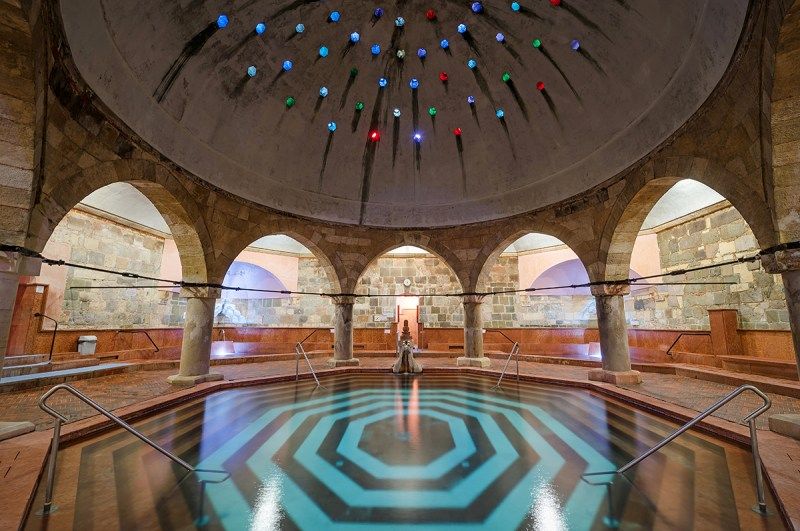
Photo: pinterest.com
Rudas is terrific for many reasons. Unlike the previous two baths, this is an Ottoman-era number. In fact, the Turkish Room, which was reconstructed, but still maintains its original stones and foundations and most importantly the atmosphere, was built in the 16th century.
In many ways, that’s all that needs to be said: here you have the opportunity to relax within the confines of a mid-16th-century Ottoman-era bathhouse and stare up at a cupola dome with rainbow lights reflecting and glimmering off of the healing waters. And surrounding the main Turkish pool are four others at various temperature gradients, as well as a freezing cold plunge pool and blistering hot saunas and steam rooms. If that were all that Rudas had to offer, it would be more than worth the trip.
But at Rudas, you are also treated to a separate wellness area that has plenty more bathing options, although the water here lacks the traditional pungency of that in the Turkish room which is sourced straight from the thermal springs.
There is a well-appointed Sauna World with various options and the kicker, the cherry on top, is of course the roof jacuzzi with views of the Danube. Probably not the cleanest tub in the world, truth be told, sit back and relax with views of majestic Budapest.
Lesser-known thermal baths
Lukács Bath
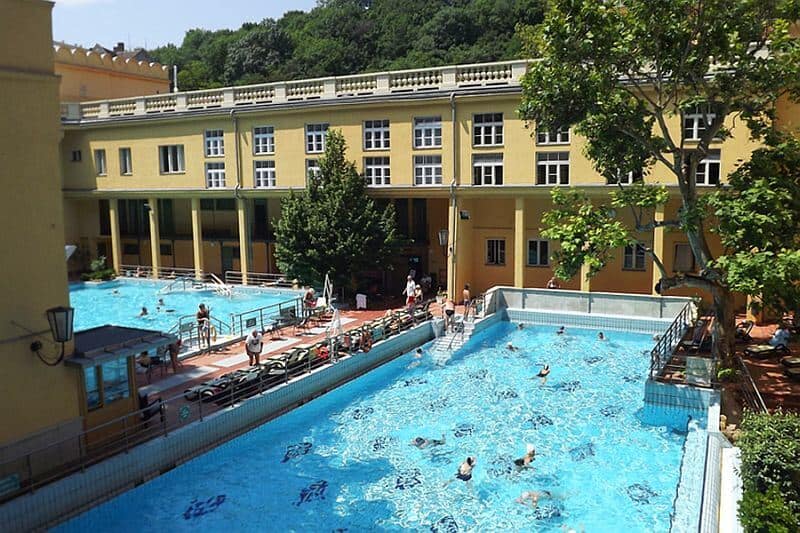
Photo: termalfurdo.hu
Lukács Bath has basically everything that Széchenyi does at half the price and twice the amount of locals. This is a real bathers bath. And you know the water is top of the line here because it is literally attached to a proper medical facility where many of Budapest’s older residents come to take treatments for all sorts of ailments. Now, that part of Lukács is totally separate from the Spa itself, but it’s nice to know that you are getting stuff that is good enough to be used in an actual medicinal setting.
So, while Lukács, the building itself, is an architectural wonder from the turn of the 19th century, the actual bathing chamber is nothing too special. It’s more functional than ornate. However, it’s still plenty lovely and the pools are well-designed, arranged and spaced out.
There are plenty of saunas and steam rooms, especially if you buy a pass to sauna world (which is only a bit extra) and there is also a lovely outdoor pool. Those who get curious can amble around the Lukács maze and make their way up to the roof for a great spot to tan in the summer.
Veli Bej Bath
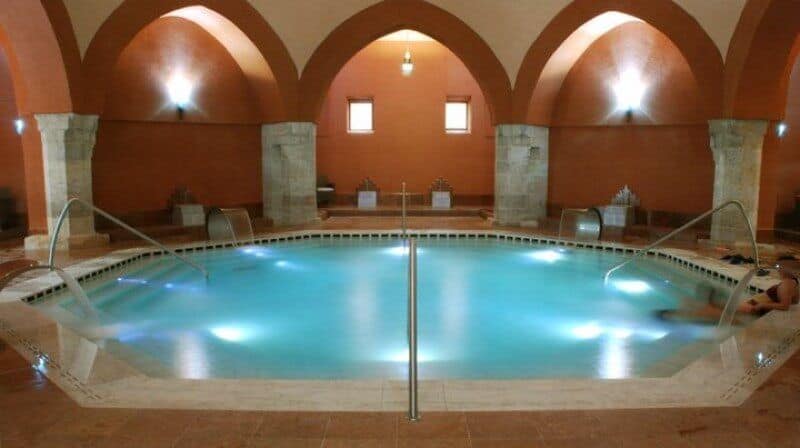
Photo: termalfurdo.hu
Right next door to Lukács is Veli Bej, which used to be known as the Császár, or emperor bath. It is also Ottoman in design, though much more thoroughly renovated than Rudas. Design-wise it has the signature cupola dome and a similar layout, but it does lack a bit of the time machine appeal of Rudas. Sadly, the best atmosphere of any of the Turkish baths, Király, has been closed since COVID times, but those who are curious can still pay a visit to see the exterior of that institution.
And in its place, Veli Bej does a fair job of replicating the spirit. And for those who value hygiene and a more modern aesthetic, it is more than an ample option. It is just around the corner from Lukács, but be sure to check the opening hours, because this bath operates on two shifts, with a break in the middle of the day.
Pesterzsébet Salt and Iodine Health Bath

Photo: pesterzsebetifurdo.hu
In terms of pure quality, this might just be the best overall bath in the whole city. And it is pretty much totally undiscovered by tourists. Lying along the river, next to a wonderful stretch of Danube with a modernized walkway and delicious dining options, lies the Pesterzsébet Salt and Iodine Health Bath.
The facility is really exquisite, recently updated, but still carrying tons of charm. Terrific details everywhere, plenty of space for bathing, indoors and outdoors, and even a whole separate room dedicated specifically to medicinal water.
An absolute hidden gem at a big discount to the main tourist spots. Also has the added advantage of having a 95% local clientele.
Dandár

Photo: termalfurdo.hu
Dandár is a compact little bathhouse in District IX aka Ferencvaros. It was built in the interwar period, but its 1978 renovation is the key to some of its socialist aesthetic. It’s certainly not the type of lavish, turn-of-the-century bathing aesthetic that you will get from your Széchenyis, your Gellérts, and your Lukács’s, nor does it have the history of the Ottoman haunts. But instead, Dandár has authenticity.
The word itself means brigade, as in the military sense of the word, and there is a certain militaristic efficiency to this place. But it has a lot of charming features, a nice outdoor section, well-heated saunas and steam rooms, and a veritable party atmosphere in the kidney bean-shaped outdoor pools on certain evenings on the weekends.
The water quality is purported to be just as good for the joints as anywhere else in town, and it rings in at an incredibly low price.
Bonus, the Unicum factory is right next door. A one, two punch for the ages.
Paskál Spa and Swimming Pool
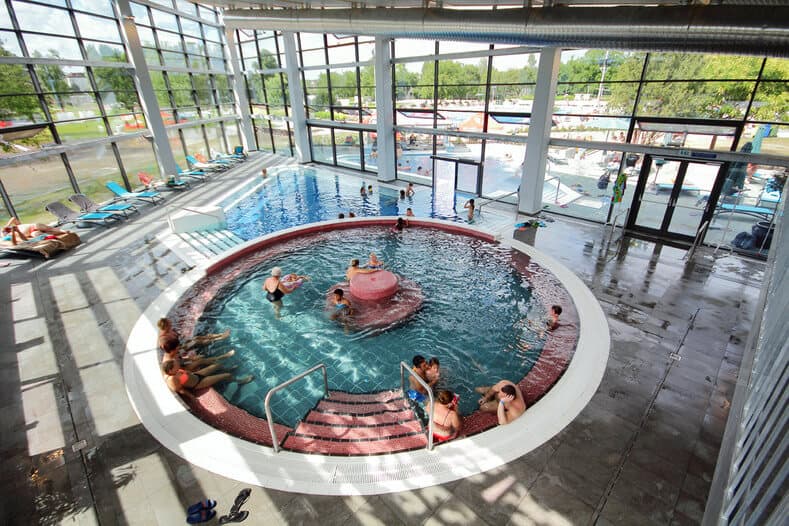
Photo: paskalfurdo.hu
Paskál is really a hidden gem for most tourists, as is the Zugló neighborhood which surrounds it. Budapest’s District XIV, which begins on the upper edge of the City Park, is beloved by residents for its green streets, family residences and overall suburban feel. And the Paskál bath house sort of epitomizes this atmosphere.
It is a family-friendly, cozy, local-feeling place. Not only is it mostly Budapest residents here, but it’s literally usually people who live in Zugló. And honestly, if you did live in Zugló, you would be a bit nuts to not come here to bathe at least once per week.
Outdoor Strands
These can be categorized as a whole separate category of experience and are better visited in the warmer months. They are what are known as strands. Many of the most famous bathhouses in the countryside also have this layout. Essentially the focus is on a massive sprawling outdoor section with plenty of lawn chairs, various food vendors, big swimming pools and some outdoor medicinal thermal water as well.
Most of them in Budapest have relatively condensed indoor sections compared to the countryside, where you can find amazing indoor areas as well. Anyway, they are all great to visit, but certainly not the more classic Budapest bathhouse experience.
Palatinus Strand Baths

Photo: facebook.com/cintanyeros
Sprawling complex with indoor, but mostly outdoor bathing options, water slides and lovely lounging space. Located in the middle of Budapest’s famous Margit Island.
Dagály

Photo: facebook.com/regijokifozde
Right across from Margit Island on the Pest side (in District XIII). Gargantuan outdoor area with sports fields, lounge chairs, plenty of pools, food and suntanning spots. A compact indoor section and modernized sauna facilities. Retro, socialist era feel.
Csillaghegy
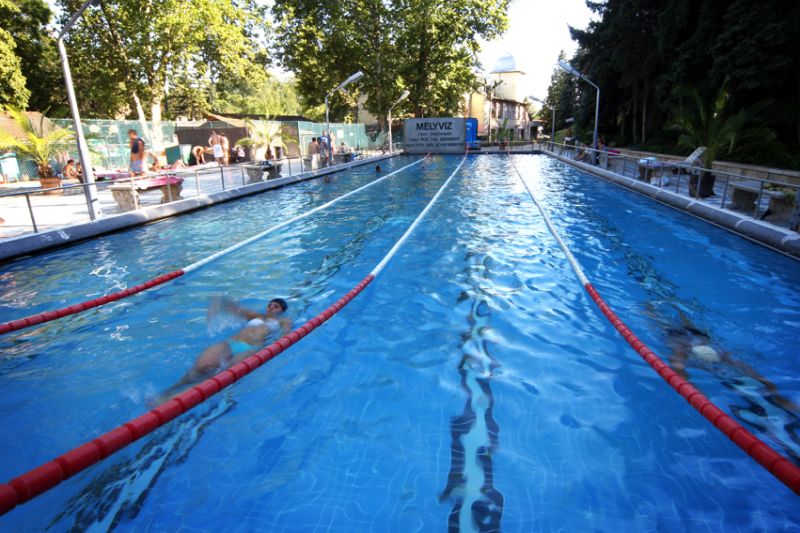
Photo: csillaghegyifurdo.hu
An enigmatic place, perched on a hill in Csillaghegy. Not the best bathing option to be honest, but a fantastic, fantastic sauna facility, and plenty of historical nooks and crannies to explore inside of a thoroughly renovated, multi-story complex complete with restaurants and waterslides.
Római Open-air Baths

Photo: romaistrand.hu
Old school, Budapest outdoor bathing experience. It is in the neighborhood literally called Roman Bath. Added advantage of being situated along the Roman shore with its plentitude of dining, drinking, and entertainment options (especially in the warmer months).
Frequently Asked Questions
Are Budapest Thermal Baths worth it?
Yes. Probably the most worthwhile tourist activity you can do. However, the value options on this list are much more worth it than the others.
How long do you need at the thermal baths in Budapest?
2 hours is the length of an average visit. Most of the passes last as long as you would like, and many people camp out for the day. You can bring a book or three, some snacks, and enjoy an extended session. 90 minutes should be the minimum.
Do I need flip-flops for Budapest baths?
Usually, it is required, though little enforced. But ew. Come on, wear flip-flops, for your own sake.
Do you wear clothes in Budapest baths?
Almost all of the bathing facilities at this point are co-ed and bathing attire is required. Exceptions are the single-gendered times at Rudas where a traditional loincloth is provided. These are usually in the morning hours during the week, but please check the schedule ahead of time as it varies and there is nothing worse than showing up for the wrong gendered session when you are ready to plonk yourself into an Ottoman-era tub. There are also a few saunas around these various baths where you will need to go in with only a textile.
What is the best time of day to visit the Széchenyi Baths?
Our tip is to visit Széchenyi on an off-peak hour. Preferably in the early morning if you come on a weekend, or the odd Monday, Tuesday, or Wednesday evening.
Do you get a towel at Budapest Baths?
No. Bring at least one of your own, but better to bring two so you can use one for the saunas and patting dry and lying down on, and one to dry off with at the end of your session.
Can you take photos in Budapest baths?
Mostly yes. But please be respectful of privacy and self-aware of the atmosphere. For example, guests at Széchenyi Bath all expect tons of tourists taking photos, whereas in some of the smaller and local places you will get dirty looks. On a case-by-case basis, but take one picture and enjoy the bath.
What to bring to a thermal bath in Budapest?
At least 2 towels, a bathing suit, a change of clothes, a plastic bag (usually they have these or a centrifuge to dry stuff, but just in case), and your favorite book.


Sorry, the comment form is closed at this time.